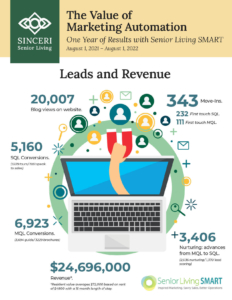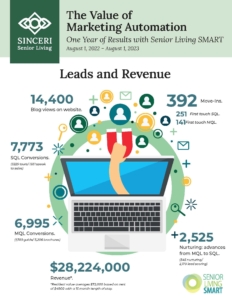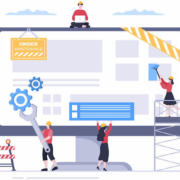Marketing Automation for Senior Living: Real Results
We spend a lot of time on the blog and with our clients discussing the value of marketing automation for senior living. But the proof is in the results. Below, we’re highlighting what two years’ worth of sound marketing strategy and automation achieved for Sinceri Senior Living, which is based out of Vancouver, Washington, and has over 70 communities across the U.S.
But first, let’s have a quick refresher on marketing automation.
Why does marketing automation for senior living matter?
Marketing automation enables you to send the right message to the right person at the right time. As its name suggests, everything happens automatically in the background. A website visitor’s actions enable marketing automation to glean the visitor’s intent and give them a lead score. The score helps determine the next steps.
For example, if someone downloads a guide about retirement planning and indicates they want to move to an independent living community within a couple of years, they would receive a different score than someone who requests a tour next week because their mom needs memory care ASAP.
The former would be considered a marketing-qualified lead (MQL). They’ve indicated intent and interest, but they’re not ready to buy now or any time soon. They’ll enter lead nurturing workflows designed to keep them engaged.
The latter is a sales-qualified lead (SQL). They’ve indicated sales readiness through their actions and the info provided through the tour request.
The marketing automation can keep track of everyone—who they are, their lead score, and what should happen next. The automation also frees up the marketing and sales team from mundane, repetitive processes—and the automation can quickly scale to accommodate multiple communities.
So, instead of keeping track of who’s who and when to send emails, the marketing team can focus on developing engaging content that attracts more qualified traffic to the website—think blog posts, videos, and social media content. Meanwhile, the sales team can focus on high-intent leads instead of wasting time working “all leads,” which has traditionally been the approach in senior living.
OK, so all of this might sound well and good in theory. But how does marketing automation work in practice? Is everything as seamless as we described above? And what about the results?
Below, we’re sharing two years’ worth of results for Sinceri Senior Living: August 2021 to August 2022, and August 2022 to August 2023. Sinceri is a prime example of how automation can enhance marketing efforts, streamline processes, and, most importantly, drive tangible results.
Year one: Building a solid foundation

The stories behind the numbers
Sinceri’s blog enjoyed an impressive 20,007 views, a crucial indicator of increasing online engagement. The real success, however, was evident in the conversion rates. The MQLs stood at 6,923, a significant portion of which (3,694) came from guide downloads and 3,229 from brochure downloads.
The SQLs were even more telling of the strategy’s effectiveness, with 5,160 conversions comprising 3,229 tours and 1,931 requests to speak with sales representatives. This successful nurturing of MQLs to SQLs was marked by 3,406 advancements, a testament to the effective combination of email nurturing and lead scoring.
The move-ins may be the most compelling evidence of the automation strategy’s success. Out of 343 total move-ins, 232 were attributed to first-touch SQLs and 111 to first-touch MQLs, translating into a remarkable $24,696,000 in revenue, considering the average resident lifetime value.
Year two: Refining strategy and focusing on quality

The stories behind the numbers
The second year (August 2022 to August 2023) showed an interesting trend. Although blog views decreased to 14,400, this wasn’t necessarily a setback. In fact, it highlighted a more targeted and quality-driven approach to traffic acquisition. The MQLs slightly increased to 6,995, indicating more efficient conversions despite lower traffic. The brochure downloads significantly rose to 5,206, showing a shift in user preference and content effectiveness.
The SQLs saw a notable increase to 7,773, underscoring the efficiency of the nurturing process. The number of move-ins also rose to 392, with a higher proportion of first-touch SQLs (251) than first-touch MQLs (141). This translated into a staggering $28,224,000 in revenue, further cementing the effectiveness of marketing automation in driving real financial outcomes.
The value of marketing automation for senior living operators
The above results demonstrate the value of marketing automation for senior living communities. The results include:
- Enhanced engagement: Automation tools help the right leads receive the right messages at the right time, boosting engagement and conversions to the next steps.
- Improved conversion rates: The transition from MQLs to SQLs and then to actual move-ins highlights how automation streamlines the lead nurturing process and positively impacts conversions.
- Increased revenue: The substantial rise in revenue over two years highlights the direct financial benefits of adopting a well-strategized marketing automation system.
Sinceri Senior Living’s experience with marketing automation offers invaluable insights for other senior living communities. It demonstrates that with the correct setup and strategy, marketing automation isn’t simply a tool for efficiency; it’s a pathway to meaningful engagement, better conversions, and significant revenue growth.
Want to turbocharge your community’s marketing? Let’s talk!
We can help you implement marketing automation so that it delivers the ROI you crave. Get in touch and let’s talk about marketing automation.






